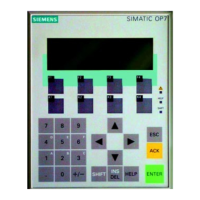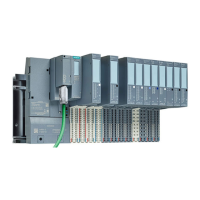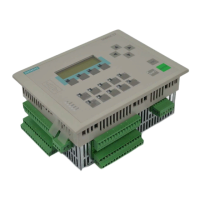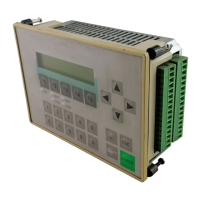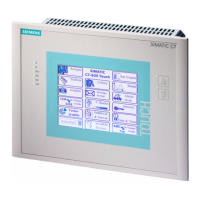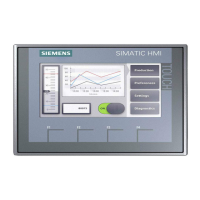
Do you have a question about the Siemens SIMATIC HMI KTP400 and is the answer not in the manual?
| Display Type | TFT LCD |
|---|---|
| Resolution | 480 x 272 pixels |
| Color Depth | 64k colors |
| Operating Temperature | 0 to 50°C |
| Storage Temperature | -20 to 60°C |
| Voltage Supply | 24 V DC |
| Mounting Type | Panel Mount |
| Number of Keys | 4 function keys |
| Touchscreen | Yes |
| Relative Humidity | 10% to 90% (non-condensing) |
| Protection Class | IP65 (front) |
| Communication Interfaces | PROFINET, USB |
Application examples illustrate automation tasks and are a free service from Siemens. They are non-binding and require user responsibility.
Siemens disclaims liability for usability, completeness, and defects of application examples, except for mandatory liability cases.
Siemens reserves the right to change examples; other documentation takes precedence in case of discrepancies.
Siemens provides industrial security functions; users must implement a holistic security concept for secure operation.
This LOGO! set expands house control with a weather station and a Basic Panel, covering automatic control of blinds, lights, heating, and garden watering.
Presents a schematic layout of the most important components of the house control solution using LOGO! and weather sensors.
Details the LOGO! Set 11 hardware expansion with a weather station, LOGO! 8, and a Basic Panel, listing advantages and benefits.
Lists the specific hardware and software components used in the application example, including article numbers and notes.
Lists the zip file contents and projects used in the example, including LOGO! Soft Comfort, WinCC projects, and web projects.
Explains how wind and light sensors control blinds based on speed and irradiation, prioritizing safety and comfort.
Details how twilight sensors manage lighting and rain sensors control garden watering and roof hatch operations.
Describes temperature sensor use for roof hatch and heating control based on ambient and external temperatures.
Guides on setting up network mode and interconnecting LOGO! devices using LOGO! Soft Comfort.
Details connecting function blocks and exchanging data between LOGO! devices via drag-and-drop in the diagram editor.
Provides instructions on creating sets, connecting them with LAN cables, and observing installation information from other sets.
Offers setup guidelines for the KTP400 Basic Panel, including IP address and subnet mask configuration.
Notes that IP address or master-slave mode changes for LOGO! 8 are only possible in "STOP" mode.
Step-by-step guide to assign IP addresses and set the master/slave mode for LOGO! controllers using the LOGO! display.
Assumes LOGO!Soft Comfort V8 and WinCC are installed on the PC; no prior experience is required.
Refers to LOGO! Set 9 for downloading programs and web server access settings for commissioning.
Explains that KTP400 IP address can only be changed when Runtime is stopped.
Details network interface settings for the KTP400, including IP/subnet assignment, Ethernet parameters, and PROFINET device name.
Guides on loading a project onto the HMI panel, enabling data channels, and starting the project after transfer.
Instructs on configuring the PC's operating system, specifically the PG/PC interface, for Ethernet communication with LOGO!.
Lists devices and the corresponding program files to be used from the zip file for the KTP400 and KTP700.
Provides steps to start WinCC and open the project for loading into the KTP400 and KTP700.
Details how to configure connections, IP addresses, and PLCs within the WinCC project for the KTP400.
Explains how to select the PC's Ethernet interface, load the project to the KTP400, and confirm the download.
Overview of configured warning messages for wind speed levels in the KTP700 WinCC project, including message text and color.
Details how to navigate to HMI alarms in WinCC, specifying trigger tags and limit values for warning messages.
Guides on displaying values in warning messages by inserting tags and assigning alarm classes and background colors.
Explains how to enable configured warning messages in the alarm window's properties for current and unacknowledged alarms.
Describes the KTP400 screens, including the uniform toolbar and buttons for Start, Weather, System, and Support.
Details the uniform toolbar on KTP screens and the navigation buttons for accessing different screens.
Shows the initial screen displayed immediately after the system starts, featuring the LOGO! 8 weather station.
Displays the current measured values from the weather sensors on the KTP400, showing temperature, lux, rain, and wind speed.
Lists and describes the system functions available on the KTP400, such as Clean Screen, Calibrate, (Data) transfer, and Runtime Stop.
Provides information on accessing Siemens Industry Online Support for FAQs, application examples, and videos via the Home button.
Explains how to verify automatic mode on KTP700, how wind speed affects blinds, and how KTP700 displays warning messages.
Details how to open the alarm window, view wind speed warnings, and acknowledge messages on the KTP700.
Shows how to close the message window after clearing alarms and how blinds automatically close based on wind and irradiation.
Guides on operating the application example via PC using WinCC simulation, including starting the runtime simulator.
Information on Siemens Industry Online Support, SITRAIN training, and the Online Support app for assistance and resources.
Lists references for LOGO! 8 and LOGO! MTS, including authors, publishers, and ISBNs.
Provides a table of internet links related to Siemens Industry Online Support, LOGO! 8 manual, and HMI KTP400 manual.
Details the version history of the document, including dates and modifications made in each version.
